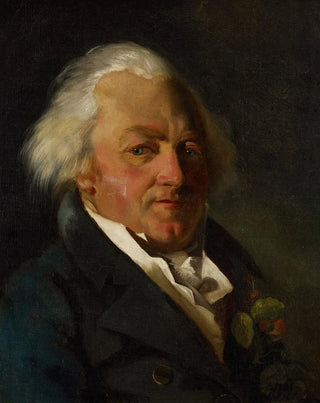Art print | Portrait of Simon Bonnesoeur Bourginire - Théodore Géricault Source: Reproduction | Portrait of Simon Bonnesoeur Bourginire - Théodore Géricault


View from behind

Frame (optional)
Portrait of Simon Bonnesoeur Bourginire - Théodore Géricault – Engaging Introduction
At the heart of the Romantic movement, Théodore Géricault's work stands out for its ability to capture the human essence in all its complexity. The "Portrait of Simon Bonnesoeur Bourginire" is a perfect example, revealing not only the artist's technical talents but also his deep understanding of human emotions. This portrait, imbued with dramatic intensity, invites the viewer to delve into the intimacy of the model, Simon Bonnesoeur Bourginire, whose gaze seems to tell a story far beyond the canvas. In this piece, Géricault does not merely depict his subject; he humanizes him, giving him an almost palpable presence.
Style and uniqueness of the work
Géricault's style is characterized by striking realism, combined with a romantic sensitivity. In the "Portrait of Simon Bonnesoeur Bourginire," the artist uses contrasts of light and shadow to emphasize facial features, creating an atmosphere of depth and mystery. Every detail, from the folds of clothing to the nuances of the flesh, is carefully crafted, demonstrating meticulous observation. The color palette, subtly chosen, enhances the emotion conveyed by the portrait, making the work both lively and timeless. This blend of impeccable technique and emotional expression makes this piece a masterpiece of Romanticism, where beauty and melancholy meet.
The artist and his influence
Théodore Géricault, born in 1791, is often regarded as one of the pioneers of Romanticism in painting. His work, marked by a quest for truth and emotion, profoundly influenced subsequent generations of artists. Géricault mastered evolving the portrait by incorporating narrative elements, transforming simple representation into an exploration of psychological depths. His engagement with contemporary subjects, such as the human condition and social dramas, paved the way for a new artistic approach. By depicting Simon Bonnesoeur Bourginire, Géricault does not just paint an individual; he immortalizes an era, a state of mind, a perspective

Matte finish

View from behind

Frame (optional)
Portrait of Simon Bonnesoeur Bourginire - Théodore Géricault – Engaging Introduction
At the heart of the Romantic movement, Théodore Géricault's work stands out for its ability to capture the human essence in all its complexity. The "Portrait of Simon Bonnesoeur Bourginire" is a perfect example, revealing not only the artist's technical talents but also his deep understanding of human emotions. This portrait, imbued with dramatic intensity, invites the viewer to delve into the intimacy of the model, Simon Bonnesoeur Bourginire, whose gaze seems to tell a story far beyond the canvas. In this piece, Géricault does not merely depict his subject; he humanizes him, giving him an almost palpable presence.
Style and uniqueness of the work
Géricault's style is characterized by striking realism, combined with a romantic sensitivity. In the "Portrait of Simon Bonnesoeur Bourginire," the artist uses contrasts of light and shadow to emphasize facial features, creating an atmosphere of depth and mystery. Every detail, from the folds of clothing to the nuances of the flesh, is carefully crafted, demonstrating meticulous observation. The color palette, subtly chosen, enhances the emotion conveyed by the portrait, making the work both lively and timeless. This blend of impeccable technique and emotional expression makes this piece a masterpiece of Romanticism, where beauty and melancholy meet.
The artist and his influence
Théodore Géricault, born in 1791, is often regarded as one of the pioneers of Romanticism in painting. His work, marked by a quest for truth and emotion, profoundly influenced subsequent generations of artists. Géricault mastered evolving the portrait by incorporating narrative elements, transforming simple representation into an exploration of psychological depths. His engagement with contemporary subjects, such as the human condition and social dramas, paved the way for a new artistic approach. By depicting Simon Bonnesoeur Bourginire, Géricault does not just paint an individual; he immortalizes an era, a state of mind, a perspective






